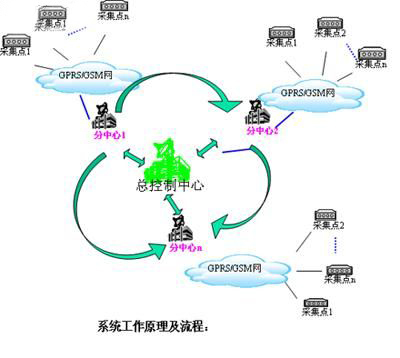1、 Design of hydrological information collection, transmission and communication network
The main task of gprs modem DTU water conservancy and hydrology applied to hydrological survey is to measure the natural changes of hydrological elements such as rainfall, water level and flow of rivers, lakes and reservoirs. It is a basic and preliminary work and the ears, eyes and staff of flood control and drought relief. Its quality and accuracy will directly affect the real-time and accuracy of water information and the scientificity and accuracy of flood control and drought relief decision-making It is urgent to strengthen the infrastructure construction of flood reporting stations, strengthen the collection and transmission of water regime information, and improve the quality of water regime measurement and reporting.
1. Overall functional requirements
(1) The time for the hydrological sub center to correctly receive all hydrological parameters of all affiliated telemetry stations at one time shall not exceed 20 minutes, and the time for performing data acquisition of regional telemetry stations and completing data transmission, processing and warehousing shall not exceed 20 minutes.
(2) Working mode: self reporting mode, response mode and self reporting response mode. The three working modes can be mixed in the system at the same time.
(3) Automatically collect water level and precipitation data, transmit data regularly and timely, and the data can be stored in the station for a long time.
(4) All equipment shall comply with the principles of simple structure, reliability and low power consumption; All telemetry stations can work unattended.
(5) It can work reliably for a long time, especially under severe weather conditions such as rainstorm and flood, and the loss of hydrological data due to the failure of sub central station shall be avoided.
(6) The system sends clock synchronization signal regularly, and the whole system clock is synchronized.
(7) Illegal data alarm and equipment fault alarm.
(8) The communication unblocked rate shall be more than 98%, and the system bit error rate shall be less than 6 x 10 ¯ 5.
(9) Capable of data communication with other relevant computer network systems.
(10) System MTBF > 20000 hours.
(11) All have reliable lightning protection measures.
(12) The wired program-controlled telephone shall be adopted, and the data acquisition time of single station shall be less than 40 seconds.
2. Hydrological information collection method
Because the traditional water level and rainfall data acquisition equipment can not meet the needs of telemetry system, it must be updated or transformed to realize the digitization, automatic acquisition and long-term automatic storage of hydrological information, so as to meet the application requirements of modern digital communication and computer.
Construction of hydrological telemetry system; Determine three information collection methods: rainfall collection method, water level collection method and flow collection method.
3. System communication network design
Existing communication resources available within the jurisdiction include:
① PSTN resources of program-controlled telephone switching network.
PSTN (public switch g telephone network) is a new communication transmission means with the advantages of wide application range, simple equipment, high reliability, flexible networking, low cost and convenient maintenance. It is one of the communication channels recommended by the national flood control command system. Its disadvantage is that it requires the system to run the call cost and the operation cost is high. If the interval between sending data is increased, the water and rain data of the station can not be reflected in time and in real time. At present, all flood reporting stations have conditions for installing program-controlled telephones.
② Wireless mobile communication (GPRS and mobile phone GMS SMS) resources.
Wireless mobile communication network has the advantages of stability and reliability, wide coverage, strong network capacity, low communication cost and no geographical restrictions. Its biggest advantage is the small volume of equipment; It is installed indoors without lightning inducing parts, so lightning protection treatment is not required. It includes: (1) advanced nature, with the development of mobile communication technology, GPRS communication based on packet has been implemented. And continue to develop in the direction of 3G. ③ Reliability, as a commercial telecommunication operation network, its reliability is quite high, and the information transmission and reception are safe and reliable without loss. ③ Practicability, GSM, as a mature and practical network, has been able to meet the needs of users, realize resource sharing and information exchange. ④ Economy: firstly, the use of mobile communication does not require investment in network construction, nor does it need to rent communication lines. Secondly, the communication cost is low, and GPRS is charged only when it generates communication traffic; The cost of sending a message by GMS short message is 0 1 yuan, no charge for the receiver. Therefore, it can be considered as a preferred communication mode in hydrological data transmission and communication. Disadvantages: limited network coverage. At present, all the central flood reporting stations in our city are in the coverage area of mobile communication, and the local flood reporting stations at the township level and surrounding areas can also use mobile communication.
③ Ultrashort wave resources and UHF / VHF band ultrashort wave is a kind of ground visual communication. It is mainly suitable for water monitoring and reporting system in plain and hilly areas with less number and number of relay stations.
This communication mode has the advantages of good communication quality, simple equipment, short construction cycle and easy implementation. However, if this communication method is used to transmit hydrological data in the case of long-distance and multi mountain obstruction, the number of relay stations and transfer times will increase significantly, resulting in the increase of equipment cost and civil engineering cost, the decline of system reliability, the poor traffic conditions at the relay station site, and some difficulties in construction, installation and maintenance.
④ Satellite communication resources.
Satellite communication has the advantages of long transmission distance, wide communication frequency band and large transmission capacity; The networking is flexible, not limited by geographical conditions, and the station construction cost and communication cost have nothing to do with the communication distance. The disadvantage is that the station construction cost and communication use fee are high. With the rapid development of modern communication technology, the above four communication modes have been widely used in hydrological measurement and forecasting system. The communication mode of the system shall be based on the geographical environment conditions and actual needs; On the basis of analysis and demonstration, it is determined according to local conditions.

2、 System networking structure
A. Channel design
Channel refers to the medium for transmitting signals and is the basic part of communication network. Scientifically select the channel to make the signal transmit effectively and reliably; It is a basic problem of communication design.
According to the available communication resources within the jurisdiction and the existing actual situation: the wired program-controlled telephone can reach all flood reporting stations. The central flood reporting station and the local flood reporting stations in and around the township are located in the coverage area of mobile communication. It is considered to make full use of the existing resources and the development trend of today's communication and network technology, and to facilitate operation and management after the completion of the system, Ensure the smooth, effective and practical information of the system, save investment and ensure the reliability of the system. In this construction, the Internet public network is mainly used as the communication channel. Overall design scheme: wireless mobile communication (GPRS and GMS short message) is used as the main channel and wired communication (PSTN) is used as the standby channel for hybrid networking. It is equipped with "dual channels" to back up each other and set the priority of communication in advance. When the main channel fails, it will automatically switch to the standby channel; When the main channel returns to normal, it will return to the main channel to transmit data. The specific scheme is as follows: for the flood reporting stations in the coverage area of mobile communication and accessible by wired program-controlled telephone, the wireless communication (GPRS and mobile GSM short message) is the main channel and PSTN is the backup channel for data transmission; For the flood reporting station with thread control telephone only, the wired communication PSTN is used as the main channel for data transmission, so as to completely solve the manual flood reporting mode of each flood reporting station. The advantages of using Internet public network channel networking are: avoiding the maintenance and management of self built private network from newspaper; In case of problems, it is maintained by the post and telecommunications system, which also avoids the same frequency interference of wireless communication and has high transmission quality; The equipment is simple, and do not specially equip with power supply; The equipment investment is lower than that of other terrestrial wireless channels. Therefore, this networking scheme is feasible and reliable.
The city has a wide range and high mountains. The number of relay stations and transfer times required for the establishment of ultrashort wave will increase significantly, resulting in the increase of equipment cost and civil engineering cost and the decline of system reliability. Therefore, no ultra short wave network will be established in this design. Due to the large investment, satellite channel is not used in the design.
B. System networking structure design
The network structure design is to connect each flood reporting station with the sub center in what form. The topography of the stations under the jurisdiction of the hydrological sub center is complex. There are many upstream rivers; The stations are widely distributed; Fan shaped distribution; There are some difficulties in communication networking. In order to achieve the goal of transmitting all the water regime information of subordinate flood reporting stations to the sub center within 20 minutes and ensure the reliability of the system, the structure of flood reporting communication network is designed into a single star network structure according to the local actual situation. The data of the whole network station is directly transmitted to * * central station by mobile communication (GPRS and GMS short message) and PSTN channel. Advantages: it reduces the equipment investment required by the collection and forwarding station; It can avoid the interruption of the information transmission of upstream stations when the collection and forwarding station has communication failure. Disadvantages: due to the large number of flood reporting stations, all of them are directly transmitted to the sub center, resulting in the extension of communication time, and delay measures must be taken; Stations with forecasting tasks cannot directly obtain the required water regime information. The solution is: due to the large number of flood reporting stations, in order to ensure that the information of each station is collected within 20 minutes, multi-channel receiving telephone lines are adopted, and the data transmission of each station is called and measured station by station according to a certain sequence through the setting of computer software. In terms of time, it is the most economical and time-consuming, which fundamentally avoids the congestion of communication transmission from many flood reporting stations to sub centers at the same time Collision problem. Develop application software for each station and sub center with prediction task, store the received water regime information in the server, and send it to each station in time or ask for it by each flood reporting station.

 Manager Wang
Manager Wang
 OfficialAccounts
OfficialAccounts